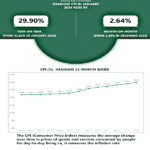In chronicling the essence of risk based supervision (RBS), JOSEPH INOKOTONG writes that the main reason for supervision entails the promotion and maintenance of efficient, fair, safe and
IN insurance, risk based supervision (RBS) is a structured, yet flexible, forward-looking process designed to identify, assess, measure, monitor and control/reduce/mitigate key risk factors to which individual insurers and the entire industry are exposed.
RBS ensures that the focus is on those risk areas that pose the greatest hazard to the insurers’ safety and soundness. It supports the regulators in achieving regulatory objectives while taking into account the need to employ resources most efficiently, effectively and ensure that interventions are in line with the assessments.
The main reason for supervision is to promote the maintenance of efficient, fair, safe and stable insurance markets for the benefit and protection of policyholders. An effective supervisory system can require an insurer to take timely preventive and corrective measures if the insurer fails to operate in a manner that is consistent with sound business practices or regulatory requirements.
Traditionally, authorities have performed this role by way of compliance-based supervision. Under this style of supervision, insurers must comply with a set of rules generally written into the law. In recent years, supervision has been evolving and moving from a style that is compliance-based to one that is risk-based.
Insurance experts say there are 10 key risks under RBS. These are insurance risk, market risk, credit risk, operational risk, concentration risk, liquidity risk, regulatory/compliance risk, reputational, strategic risk and systemic risk.
Many countries have adopted RBS and the IRA explains the numerous purposes of adopting risk base supervision by the authority.
According to the IRA, the adoption enables companies to become adequately capitalised as new minimum capital requirements are proposed. When this is done, the required capital will be commensurate to the level of risk and companies can raise additional capital through (preference shares, subordinated debt instruments)
The adoption of RBS will ensure improvements in the quality of assets that insurers/HMOs hold (a considerable number of assets are inadmissible). In the same vein, it will improve liquidity through introducing significant capital charges for property investments and by disallowing premium receivables (only receivables from government business).
Also, it will ensure players deal with highly rated reinsurers (with exceptional charges for locally registered reinsurers/insurers), ensure adequate asset-liability matching, encourage players to promptly settle claims (capital charge on claim reserves) and enhance the quality and volume of data submitted by players (monthly reporting and eventually real-time reporting).
By enabling the identification of significant risks and quantification, the adoption of RBS enhances corporate governance practices in the industry. It saves on costs and time as the focus is on high-risk areas (level of supervision will be pegged on a firm’s risk profile) and enables early identification of emerging risks (through an early warning system), that is, more forward-looking to prevent the collapse of companies.
In deploying RBS, it is pertinent to dissect the risk-based capital framework (RBC), which is a method of measuring the minimum amount of capital appropriate for an entity to support its overall business operations in consideration of its size and risk profile.
RBC requires a company with a higher amount of risk to hold a higher amount of capital.
The deployment of RBS will culminate in instituting stringent controls. The rationale for the control levels is to enable insurers to absorb significant unforeseen losses and reduce the likelihood of failure due to significantly adverse losses, including decreases in the value of assets and/or increases in the obligations of the insurer and to reduce the probability of insolvency. It is also to provide a high degree of protection for the policyholders by reducing the magnitude of losses to policyholders in the event of failure of an insurer.
Similarly, it serves to ensure that the obligations to policyholders will continue to be met as they fall due and to allow for intervention at a sufficiently early stage in an insurer’s difficulties so that there is a realistic prospect for the situation to be rectified promptly with an appropriate degree of urgency.
From a macroeconomic perspective, an adequate buffer will maintain the safety and soundness of the insurance sector and the financial system as a whole. In the IRA jurisdiction, it is stipulated that “insurers shall only pay a dividend if CAR is at least 200 percent.”
The IRA has provided for remedial actions to be taken, insisting that to support adherence to the control levels, a “ladder of supervisory interventions shall be shared with the industry. The ladder of supervisory intervention shall specify the actions that would be taken by the regulator in case of breach of the control levels.
Some of the actions could include: increased supervision and reporting, measures to address capital levels, measures that strengthen or replace an insurer management and/or risk management framework, measures that reduce or mitigate risks such as requesting additional reinsurance, stopping the activities of the insurer and withdrawal of the insurer’s license.”
It also requires “the insurer to close to new business and run-off the portfolio and transfer its portfolio to another insurer, arrange additional reinsurance, or other specified actions.”
The IRA said at the planning and preparation stages by the insurance players, the authority shall require that the players do the following in preparation for the RBS regime. It should “continuously review all pertinent documents provided by authority, evaluate the likely impact on their business, make the required preparations and raise any concerns they may have to the authority promptly.”
It also requires that it “nominate an RBS committee, including an RBS coordinator who is at senior management level. The RBS committee will be comprised of at least three members. Submit resumes of committee members. The RBS committee of the insurer/HMO should provide quarterly updates to their Board of Directors on the status of their preparation and implementation of RBS.”
Some of the possible impacts of these measures on insurers include, capital injection (based on CAR results), mergers and acquisitions, change of investment policy, competitive pricing, corporate governance aspects must be improved, new technical skills required (actuarial, risk management, etc), IT systems may require upgrades/changes, business strategies may change, own risk and solvency assessment and more frequent reporting (daily, monthly).
Under the changing regulatory landscape, experts advocate the need to strike a balance between risk and reward as some of the possible impacts on insurers may entail pushing them to go for cash and carry. It may also motivate the settlement of claims to reduce the level of insurance risk (claim reserve risk), necessitate dealing with highly rated reinsurers, necessitate asset-liability matching and quality of capital.
stable insurance markets for the benefit and protection of policyholders.






